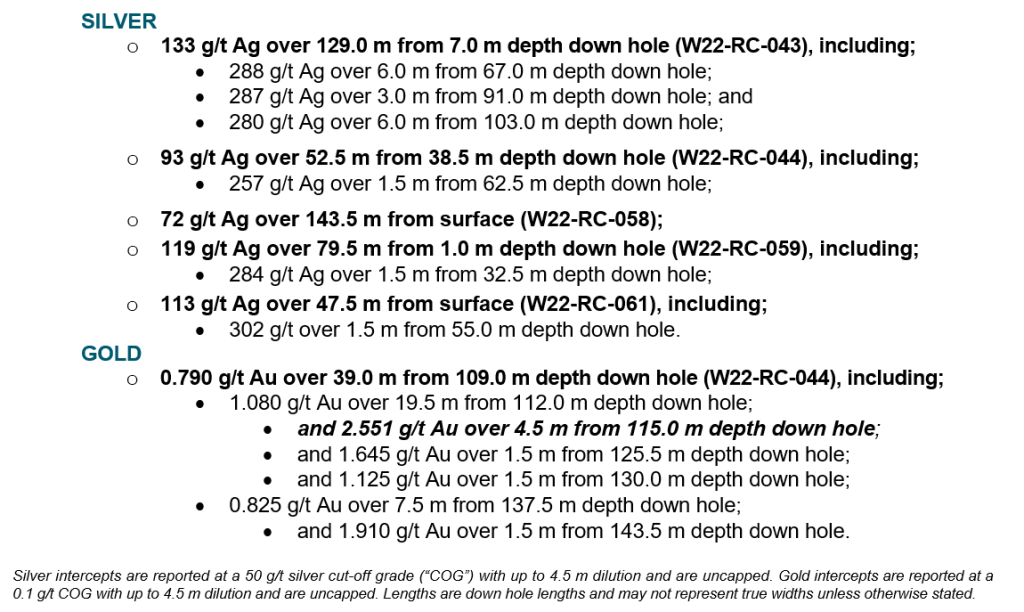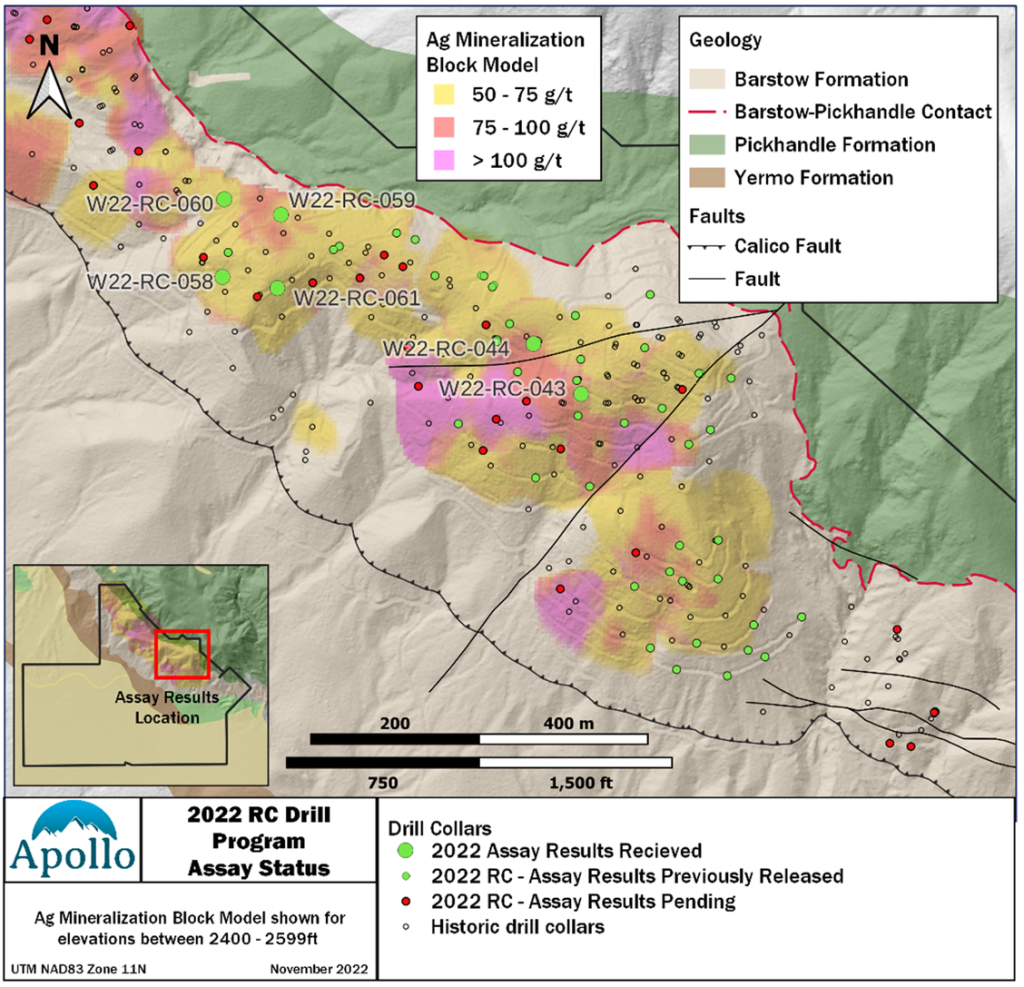
Apollo Reports First Assay Results From Phase 2 Drilling
Silver Mineralization Continues to Expand Beneath Current Resource Boundary
Apollo Silver Corp. (TSX.V:APGO) (OTCQB:APGOF) (Frankfurt:6ZF0) is pleased to report initial assay results from the recently completed Phase 2 of the 2022 Drill Program at the Calico Silver Project located in San Bernardino County, California.
Table 2: Silver assay results reported December 1, 2022, for Phase 2 of the Calico Project 2022 Drill Program. Table 3: Gold assay results reported December 1, 2022, for Phase 2 of the Calico Project 2022 Drill Program. 1.The MRE has been prepared by Derek Loveday, P. Geo. of Stantec Consulting Services Ltd., in conformance with Canadian Institute of Mining and Metallurgy’s “Estimation of Mineral Resource and Mineral Reserves Best Practices” guidelines and are reported in accordance with the Canadian Securities Administrators NI 43-101. It is effective January 28, 2022. Mineral resources are not mineral reserves and do not have demonstrated economic viability. There is no certainty that any mineral resource will be converted into a mineral reserve. Mr. Loveday is an independent Qualified Person for Apollo’s MRE. Please refer to the Company’s news release dated February 9, 2022, for more information.
SAMPLING AND QUALITY ASSURANCE/QUALITY CONTROL
Drilling was undertaken by Cooper Drilling LLC, of Monte Vista, Colorado. RC chip samples were collected in 1.5 m lifts with 15 lb representative samples sent for analysis. Representative chip samples were also collected for logging purposes (lithology, alteration, mineralization), detailed photography and analysis by portable X-Ray Fluorescence. RC samples are catalogued and securely stored in a warehouse facility in Barstow, California until they are ready for secure shipment to ALS Global-Geochemistry in Reno, Nevada (“ALS Reno”) for sample preparation and gold analysis. ALS Reno may selectively ship samples to other ALS laboratories for preparation. After preparation, splits of prepared pulps are securely shipped to ALS Vancouver, British Columbia for multi-element analysis.
Samples were prepared at ALS-Naves and ALS-Chihuahua, both in Mexico (Prep-31 package) with each sample crushed to better than 70% passing a 2 mm (Tyler 9 mesh, U.S. Std. No.10) screen. A split of up to 250 g is taken and pulverized to better than 85% passing a 75-micron (Tyler 200 mesh, U.S. Std. No. 200) screen. All samples were analyzed for 48 elements via ICP-MS following a four-acid digestion with reportable ranges for silver of 0.01 to 100 ppm (method ME-MS61). Over-range samples analyzed for silver were re-submitted for analysis using a four-acid digestion and ICP-AES finish with a silver range of 1-1,500 ppm (method Ag-OG62). When results were over 400 ppm silver, they were re-submitted for analysis by fire assay with a gravimetric finish using a 30 g nominal sample weight with reportable silver range of 5-10,000 ppm (method Ag-GRA21). Over-range samples analyzed for copper, lead and zinc were re-submitted for analysis using a four-acid digestion and ICP-AES finish with range of 0.001-50% for copper, 0.001-20% for lead, and 0.001-30% for zinc. Gold was analyzed by fire assay with atomic absorption finish (method Au-AA26) with a reportable range of 0.01-100 ppm Au. All analyses were completed at ALS Vancouver except for gold by fire assay, which was completed at ALS Reno.
The Company maintains its own comprehensive quality assurance and quality control program to ensure best practices in sample preparation and analysis for samples. The QA/QC program includes the insertion and analysis of certified reference materials, commercial pulp blanks, preparation blanks, and field duplicates to the laboratories. Apollo’s QA/QC program includes ongoing auditing of all laboratory results from the laboratories. The Company’s Qualified Person is of the opinion that the sample preparation, analytical, and security procedures followed are sufficient and reliable. The Company is not aware of any drilling, sampling, recovery, or other factors that could materially affect the accuracy or reliability of the data reported herein.
Figure 1: Locations of drill hole collars for results reported December 1, 2022, for Phase 2 of the Calico Project 2022 Drill Program. Figure 2: Assay results for drill holes W22-RC-043 and W22-RC-044 reported December 1, 2022, for Phase 2 of the Calico Project 2022 Drill Program. Figure 3: Assay results for drill holes W22-RC-058 and W22-RC-059 reported December 1, 2022, for Phase 2 of the Calico Project 2022 Drill Program.
ABOUT THE PROJECT
Location
The Project is located in San Bernardino County, California and comprises the adjacent Waterloo and Langtry properties which total 2,950 acres. The Project is 15 km (9 miles) from the city of Barstow and has an extensive private gravel road network spanning the property. There is commercial electric power within 5 km (3 miles) of the Project.
Geology and Mineralization
The Project is situated in the southern Calico Mountains of the Mojave Desert, in the south-western region of the Basin and Range tectonic province. This mountain range is a 15 km (9 mile) long northwest- southeast trending range dominantly composed of Tertiary (Miocene) volcanics, volcaniclastics, sedimentary rocks and dacitic intrusions. Mineralization at the Project comprises high-level low-sulfidation silver-dominant epithermal vein-type and disseminated-style deposits associated with northwest-trending faults and fracture zones and mid-Tertiary volcanic activity. The Project represents a district-scale mineral system endowment with approximately 6,000 m (19,685 ft) in mineralized strike length controlled by Apollo. Oxidized, disseminated and stockwork-style mineralization is primarily hosted in the Barstow sedimentary formation and is the subject of the MRE.
QUALIFIED PERSONS
The scientific and technical data contained in this news release was reviewed, and approved by Cathy Fitzgerald, M.Sc., P.Geo., Apollo’s Vice President Exploration and Resource Development, a Qualified Person as defined by NI 43-101 Standards of Disclosure for Minerals Projects. Ms. Fitzgerald is a registered Professional Geoscientist in British Columbia, Canada.
About Apollo Silver Corp. Apollo Silver Corp. has assembled an experienced and technically strong leadership team who have joined to advance world class precious metals projects in tier-one jurisdictions. The Company is focused on advancing its portfolio of two significant silver exploration and resource development projects, the Calico Silver Project, in San Bernardino County, California and Silver District Project in La Paz County, Arizona. |
MORE or "UNCATEGORIZED"
Silver North Intersects 9.10 Metres Averaging 428.3 g/t Silver and 0.73 g/t Gold from 182.40 Metres at the Haldane Silver Property, Yukon
Includes 2.80 m of 1,069 g/t silver and 1.41 g/t gold in HLD25-36... READ MORE
Coppernico Defines 155 m of Continuous Copper Mineralization Averaging 0.54% at Sombrero’s Nioc Target
Coppernico Metals Inc. (TSX: COPR) (OTCQB: CPPMF) (FSE: 9I3) is p... READ MORE
NioCorp Reports Final Assay Results From the Department of War-Funded Elk Creek Drilling Campaign
Results Support Ongoing Resource and Reserve Uplift Efforts and C... READ MORE
NGEx Drills 94.00m at 8.99% CuEq including 21.70m 31.92% CuEq at Lunahuasi
NGEx Minerals Ltd. (TSX: NGEX) (OTCQX: NGXXF) is pleased to anno... READ MORE
Aura Announces Preliminary Q4 2025 and 2025 Production Results; Record High Production and 2025 Guidance Achieved
Aura Minerals Inc. (NASDAQ: AUGO) (B3: AURA33) is pleased to anno... READ MORE




















